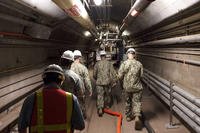SOUTHWEST ASIA -- For airlift crews out of 386th Air Expeditionary Wing, business as usual is moving thousands of pounds of gear a day in and out of combat zones. But transport specialists with the unit are also tasked with moving much more precious cargo.
And while transferring supplies -- such as ammunition, tactical equipment, building materials, fuel, food and blood packs -- is important, there's another mission these transport specialists hold nearer and dearer to their heart: preparing fallen service members for transport back to their families in the United States, a mission the military calls dignified transfer.
Senior Airman John Cox, an air transportation specialist with the 386th Expeditionary Logistics Readiness Squadron, has been a part of at least one dignified transfer since he deployed to the Middle East in February. Military.com sat down with Cox to learn more about the cargo transfer process after flying on a 12-hour operation in a C-130 Hercules to several locations in Iraq.
Related content:
- Not So Herculean: Anatomy of a C-130 Breakdown in Iraq
- Flying with the 'Blue Collar Guys' on a C-130 Mission in Iraq
- The F-22 in Syria: Deconflicting, not Dog-Fighting
Many times, the ground crews don't even know who was killed, or how they died. But that doesn't take away from the utmost care and respect they give to swiftly get someone back home to the U.S., Cox said.
"It's a very difficult thing to deal with, because it definitely puts you on a realistic level," Cox said, alluding to the fact the U.S. is still active in warzones.
Cox said the operations tempo in the Middle East has cargo crews busy as can be day in and day out. But a dignified transfer becomes a chance to focus on the reality of war, one that may not always be seen from a cockpit, 10,000 feet above the battlefield.
Since Operation Inherent Resolve, the Pentagon's name for the anti-Islamic State fight, began in 2014, there have been 42 U.S. military deaths overseas, according to the Defense Department's casualty analysis database. That number includes not only military combat deaths, but also deadly non-combat incidents ranging from training accidents in theater to untimely deaths.
The 386th has only seen a "limited" part of the dignified transfer mission -- and often, the transportation specialists don't know where the remains will travel next.
"It's a process, though," Cox said.
When remains arrive, whatever seems to be going on that day or night quickly turns to a somber moment. Cox said the usual hustle and bustle of the flightline gets quiet.
Time stands still.
"Sometimes we -- I can speak from experience from being in the Air Force, I don't see [it like] a soldier in the Army or a grunt in the Marines would see -- but it definitely brings it home when you take someone off [or put someone on] an aircraft."
He continued, "We'll all stand at attention, salute, and we'll have a few bearers that carry the coffin off of an aircraft ...with a flag draped over the top."
"It's definitely a humbling experience. It brings it all in for you."
-- Oriana Pawlyk can be reached at oriana.pawlyk@military.com. Follow her on Twitter at @Oriana0214.





























